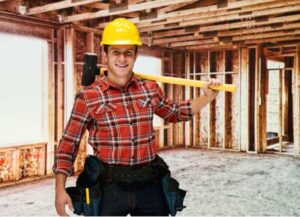Is building on a slope more expensive?
Building your home on a sloping block can be a daunting prospect—there are just so many unknowns. Going in armed with the knowledge of how much it might cost is the first step to understanding the scope of the project. So, how much extra does it cost?
On average you can expect to pay between $20,000 and $50,000 extra to build a home on a sloped block in Australia. There are a variety of factors that will influence the final number. It can be more or less depending on the foundation if there are any drainage issues, labour and building materials.
So, building on a slope can certainly set you back a lot of extra cash. Is it worth it? Read on to find out more.
How much more do you build on a slope?
 There are two primary methods for building on a slope. Firstly, the base of the house will need to be made level in some way.
There are two primary methods for building on a slope. Firstly, the base of the house will need to be made level in some way.
One way of doing this is known as the ‘cut and fill’ method. Essentially, the ground is moulded to make it level and ready for building. This is done by adding or removing soil—cutting or filling a section of the land to get the house to fit on it. This is a very common method. Because this involves more work and building resources, it will cost towards the higher end of the scale of $50,000 added to the house price.
The alternative is to use some form of stilts. Wooden or steel columns and supports are used to raise the house from the sloped ground, in order to make it level at the foundation. This can very often be a much cheaper method, as the ground itself does not have to be altered to the same extent. If this is the method taken for your house, it could be closer to $20,000 extra.
Beyond these two steps, you will need to consider what kind of plumbing you’ll have. This includes figuring out how your house sits in relation to access to the sewage system. Sometimes, a pump system is needed instead of an ordinary pipe connection. Again, this will depend on your individual case and can add to the price. Plus, building on a slope is often a more dangerous construction project, so the safety precautions and PPE for slope building will be more. While this isn’t a direct cost you will need to pay, it will be factored into the contractor cost.
What are the advantages of sloping?
The value of sloped properties is continuing to increase which could be one of the biggest factors that will make it worth your extra money. This can offer you the opportunity to have a sloped property as an asset and passive income. Of course, this is if you decide to rent the property out to boost your income. Down the line, you could get more back on your investment! But if you’re planning on having this as your forever home, why wouldn’t you spring the extra costs to have your dream house?
Figuring out if a sloping block is worth the extra money does depend on your personal taste! But part of the reason sloped real estate is so popular is that houses built there have a lot of aesthetic advantages.
For one thing, if you’re on a slope, you’re likely to have a good view, at least somewhere in the house. This is one of the big pulls of sloped houses. Sloped plots that are higher up on hills can be more expensive because of the scenery, but there’s nothing like a good view! This is something that can be harder to find these days because of the number of subdivisions and new estates being built. Hence the increase in price.
Lots of people love the appearance of a sloped garden, and the extra landscaping opportunities it grants. It’s a quite striking aesthetic, and for those of us who love gardening, it would certainly be worth the extra money.
Why do sloping blocks cost more?
The reason sloping blocks cost more comes back to the demand for them. The land alone is likely to cost more because of the demand for blocks with a view. More people want them which drives up the prices. Because of the advantages sloping houses offer, they have become very popular amongst society. Plus, people often associate houses with success which is why big houses on higher blocks are more expensive.
So, it really is a simple question of demand. The building itself will cost more because of logistical difficulties associated with sloped lots. But the block itself is more valuable because people are willing to spend more on it—like diamonds!
Is it hard to build on a sloping block?
 Building on a slope is certainly harder than building on a flat plane. But, for an experienced contractor, it will be no problem. So, the best piece of advice we can give here is to make sure to hire a reputable, experienced contractor!
Building on a slope is certainly harder than building on a flat plane. But, for an experienced contractor, it will be no problem. So, the best piece of advice we can give here is to make sure to hire a reputable, experienced contractor!
That said, one of the big difficulties with sloped constructions sites is also maintaining a place for the contractor to work. Typically, a contractor has a temporary space on-site for their work that is separate from the actual building site. This can be challenging on a sloped site and can be more time-consuming. Plus, building on angles can be more dangerous. But contractors are trained to problem solve and find the best methods to get the job done safely. They are also sure to have the best quality tools for sloped house building.
Beyond that, there will be different logistical difficulties with each site. One of the big problems is often connecting the house with local utilities. Plumbing, power, internet, all of these things can be much more difficult to link up to a house on a slope.
Finally, sloped sites are generally much more difficult to access with the kinds of heavy machinery you might need to build a house. The time required to build the foundation could be extended due to trouble with the equipment.
But, as we’ve mentioned, with the right contractor, you shouldn’t have any problem getting your dream house built on a slope. These are just things to consider along the way.
Should I buy a sloping block?
In many cases, sloping blocks are better real estate in the sense that they are more valuable and increase in value over time. They are a better investment, and if you mean to sell some years down the line, they will most likely be worth more.
For taste reasons, there are many things, as we’ve said, that make sloping blocks more aesthetically appealing. The views, the range of designs for a sloped garden, the potential extra space. There are lots of reasons why sloping blocks are “better” in those senses.
But ultimately, it is down to taste—and not all sloping blocks will provide a better view and more space than a flat one! It depends on the area and surrounding estates. You shouldn’t equate your success to your real estate but focus on what kind of house will bring you the most happiness. We wish you the best of luck on your mission to find build your perfect home!
In the meantime, check out some of our other renovation resources, including the pros and cons of a weatherboard house. Maybe our advice will help in your decision for exterior house materials. We can also tell you 11 benefits of rendering a house! For quality bricklaying, grinding and cutting tools, check out our products at Paragon Tools Australia.




